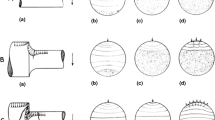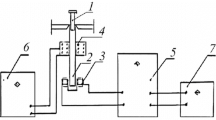Abstract
The variation of cyclic crack propagation rates, under thecombined influence of crack kinking (deflection) and fracture surface contact (closure), is estimated from simple linear elastic analyses of tilted cracks. The predictions of the models are consistent with the experimental results of linear and kinked crack advance in high strength aluminum alloys testedin vacuo. Examples of crack deflection in various engineering alloy systems and some generalizations ofaverage deflection parameters based on microstructural and mechanical factors are discussed. The individual contributions to overall growth rates from deflection and closure processes are evaluated for different mechanical and metallurgical conditions. The significance, implications, and limitations of the models are outlined.
Similar content being viewed by others
References
S. Suresh:Metall. Trans. A, 1983, vol. 14A, p. 2375.
B.A. Bilby, G.E. Cardew, and I.C. Howard: inFracture 1977, D.M.R. Taplin, ed., University of Waterloo Press, 1977, vol. 3, p. 197.
H. Kitagawa, R. Yuuki, and T. Ohira:Eng. Fract. Mech., 1975, vol. 7, p. 515.
B. Cotterell and J. R. Rice:Int. J. Fract., 1980, vol. 16, p. 155.
K.T. Faber and A.G. Evans:Acta Metall., 1983, vol. 31, p. 565.
A.K. Vasudevan and S. Suresh:Mater. Sci. Eng., 1985, in press.
S. Suresh:Eng. Fract. Mech., 1983, vol. 18, p. 577.
S. Suresh and A. K. Vasudévan: inFatigue Crack Growth Threshold Concepts, D. L. Davidson and S. Suresh, eds., TMS-AIME, War- rendale, PA, 1984, p. 361.
K. Sadananda: in Proc. ICF6, P. Rama Rao and K.N. Raju, eds., Pergamon Press, New Delhi, 1984, in press.
N. Walker and C. J. Beevers:Fat. Eng. Mater. Struct., 1979, vol. 1, p. 135.
K. Schulte, H. Nowack, and K. H. Trautmann:Z. Werkstofftech, 1980, vol. 11, p. 287.
R. J. Asaro, L. Hermann, and J. M. Baik:Metall. Trans. A, 1981, vol. 12A, p. 1133.
K. Minakawaand A.J. McEvily:Scripta Met., 1981, vol. 15, p. 633.
S. Suresh and R. O. Ritchie:Metall. Trans. A, 1982, vol. 13A, p. 1627.
S. Suresh and R.O. Ritchie: inFatigue Crack Growth Threshold Concepts, D.L. Davidson and S. Suresh, eds., TMS-AIME, War- rendale, PA, 1984, p. 227.
S. Suresh, A. K. Vasudévan, and P. E. Bretz:Metall. Trans. A, 1984, vol. 15A, p. 369.
R. D. Carter, E. W. Lee, E. A. Starke, Jr., and C. J. Beevers:Metall. Trans. A, 1984, vol. 15A, p. 555.
B. R. Kirby and C. J. Beevers:Fat. Eng. Mater. Struct., 1979, vol. 1, p. 203.
M.C. Lafarie-Frenot and G. Gase:Fat. Eng. Mater. Struct., 1983, vol. 6, p. 329.
J. Pettit: inFatigue Crack Growth Threshold Concepts, D. L. Davidson and S. Suresh, eds., TMS-AIME, Warrendale, PA, 1984, p. 3.
D. L. Davidson and J. Lankford:Crack-tip Plasticity Associated with Corrosion Assisted Fatigue, A Collection of Reprints from ONR Con- tract N0O014-75-C1O33 and unpublished related work, Southwest Research Institute, San Antonio, TX, 1983.
S. Suresh: unpublished results, Brown University, Providence, RI, 1984.
H. Suzuki and A. J. McEvily, Jr.:Metall. Trans. A, 1979, vol. 10A, p. 475.
V.B. Dutta, S. Suresh, and R.O. Ritchie:Metall. Trans. A, 1984, vol. 15A, p. 1193.
W. J. Evans: inThe Practical Implications of Fracture Mechanisms, Ser. 2, No. 10, 604-73-Y, The Institution of Metallurgists, London, 1973, p. 153.
A.K. Vasudévan and S. Suresh:Metall. Trans. A, 1985, vol. 16A, in press.
E. P. Louwaard: Delft Univ. of Tech., Dept. of Aero Eng., Report LR-243, Delft, The Netherlands, 1977.
E. J. Coyne, Jr., T. H. Sanders, Jr., and E. A. Starke, Jr.: inProc. 1st Int. Aluminum-Lithium Conf., T. H. Sanders, Jr. and E. A. Starke, Jr., eds., TMS-AIME, Warrendale, PA, 1981, p. 293.
A. K. Vasudévan, P. E. Bretz, A. C. Miller, and S. Suresh:Mater. Sci. Eng., 1984, vol. 64, p. 113.
J. Lankford and D. L. Davidson: inAdvances in Fracture Research, D. Francois, ed., Pergamon Press, Oxford, 1981, vol. 2, p. 899.
C.F. Shih: Ph.D. Thesis, Harvard University, 1973.
Author information
Authors and Affiliations
Rights and permissions
About this article
Cite this article
Suresh, S. Fatigue crack deflection and fracture surface contact: Micromechanical models. Metall Trans A 16, 249–260 (1985). https://doi.org/10.1007/BF02816051
Received:
Issue Date:
DOI: https://doi.org/10.1007/BF02816051




